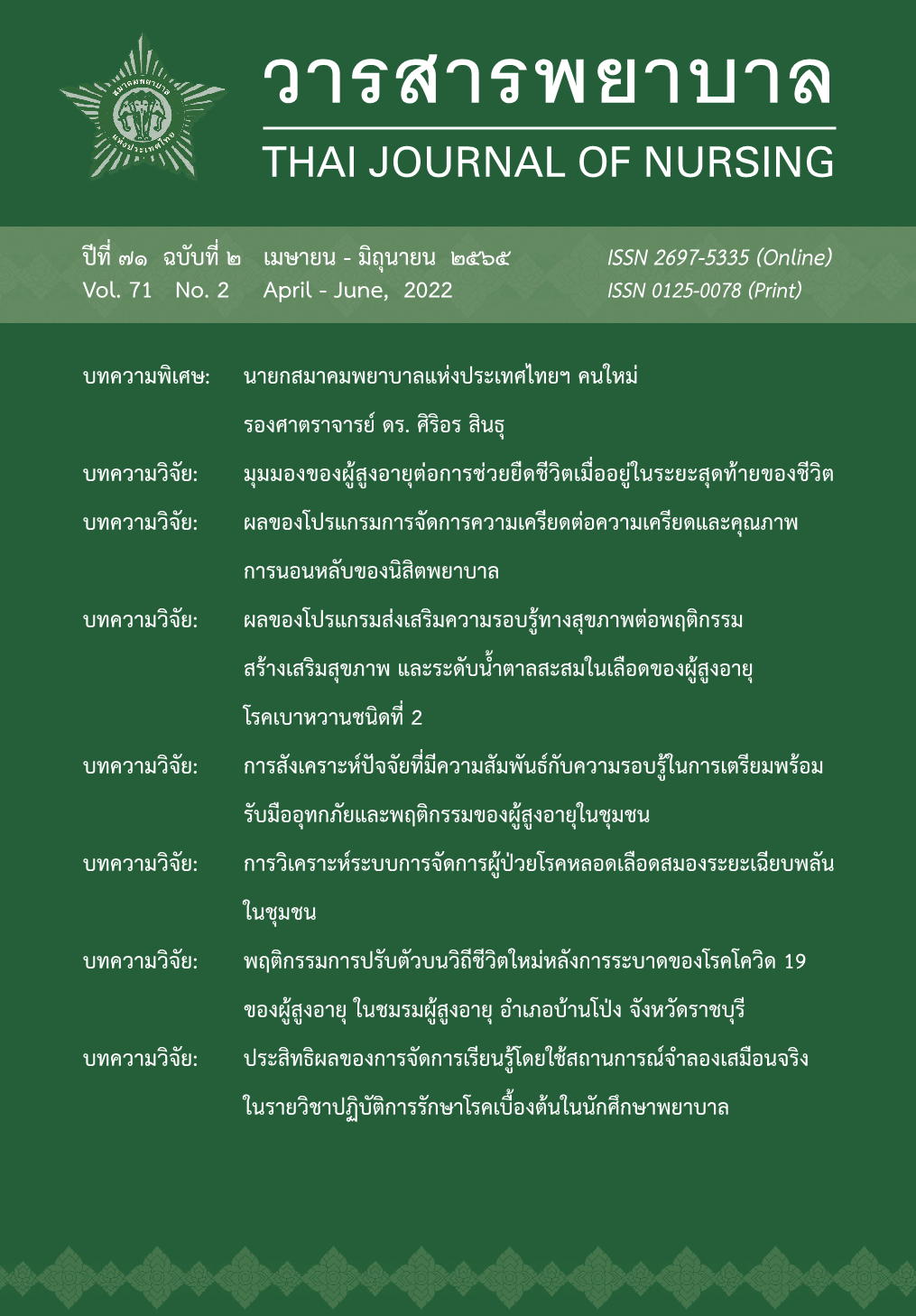การวิเคราะห์ระบบการจัดการผู้ป่วยโรคหลอดเลือดสมองระยะเฉียบพลันในชุมชน
Main Article Content
บทคัดย่อ
การวิจัยเชิงคุณภาพนี้มีวัตถุประสงค์เพื่อวิเคราะห์ระบบการจัดการผู้ป่วยโรคหลอดเลือดสมองในชุมชน ผู้ให้ข้อมูลเป็นผู้ป่วยโรคหลอดเลือดสมอง ญาติผู้ดูแล รวมถึงผู้ที่มีส่วนเกี่ยวข้องในการดูแลผู้ป่วยโรคหลอดเลือดสมองในชุมชน จำนวน 33 ราย เก็บรวบรวมข้อมูลโดยการสัมภาษณ์เชิงลึก วิเคราะห์ข้อมูลโดยการวิเคราะห์เนื้อหา ผลการศึกษาพบว่า การจัดการผู้ป่วยโรคหลอดเลือดสมองในระยะเฉียบพลัน ผู้ป่วย ญาติผู้ดูแล หรือผู้พบเห็นเหตุการณ์ขณะผู้ป่วยเกิดอาการของโรค มีส่วนสำคัญต่อการตัดสินใจนำส่งผู้ป่วยไปรักษายังโรงพยาบาล ภายใต้เงื่อนไขของการรับรู้อาการและความรุนแรงของโรค ปัจจัยส่วนบุคคล ระบบบริการสุขภาพ และบริบทของชุมชน ส่วนในระยะการดูแลผู้ป่วยต่อเนื่องในชุมชนพบว่า นอกจากผู้ป่วยและญาติผู้ดูแลที่มีบทบาทในการดุแลและฟื้นฟูสภาพผู้ป่วยแล้ว ยังมีผู้ที่มีส่วนเกี่ยวข้องอื่น ๆ ในชุมชุนเข้ามามีส่วนร่วมในการช่วยเหลือ สนับสนุนบริการสุขภาพ การจัดสวัสดิการ และการสนับสนุนเชิงนโยบายโดยผลลัพธ์ของการจัดการ ผุ้ป่วยโรคหลอดเลือดสมองในระยะเฉียบพลันในชุมชนพบว่า การรับรู้อาการและความรุนแรงของโรคที่รวดเร็ว ส่งผลต่อการเข้ารับการรักษาได้ทันช่วงเวลาบริการช่องทางด่วนฉุกเฉินผู้ป่วยโรคหลอดเลือดสมอง ส่วนการดูแลต่อเนื่องในชุมชนที่มีประสิทธิภาพของผู้ป่วย ญาติผู้ดูแล ตลอดจนผู้ที่มีส่วนเกี่ยวข้องในชุมชนนั้น มีส่วนสำคัญต่อการส่งเสริมฟื้นฟูสภาพร่างกายผู้ป่วยได้
Article Details

อนุญาตภายใต้เงื่อนไข Creative Commons Attribution-NonCommercial-NoDerivatives 4.0 International License.
เอกสารอ้างอิง
.กระทรวงสาธารณสุข สำนักนโยบายและยุทธศาสตร์. (2563). จำนวนและอัตราตายด้วยโรคหลอดเลือด
สมอง. นนทบุรี: ผู้แต่ง.
นิษฐา นันทบุตร. (2553). ระบบสุขภาพชุมชน กระบวนการทำงานร่วมกันของ 3 ระบบใหญ่ในชุมชน.
กรุงเทพมหานคร: คิวพีดี.
นิพาพร ภิญโญศรี. (2551). ปัจจัยที่มีความสัมพันธ์กับการมารับการรักษาของผู้ป่วยโรคหลอดเลือดสมองขาด
เลือดระยะเฉียบพลัน (วิทยานิพนธ์ปริญญามหาบัณฑิต ไม่ได้ตีพิมพ์). จุฬาลงกรณ์มหาวิทยาลัย,
กรุงเทพมหานคร.
บุญฑริก ค้าขาย. (2553). การฟื้นฟูสมรรถภาพผู้ป่วยอัมพาตครึ่งซีกจากโรคหลอดเลือดสมองที่บ้านโดยการ
มีส่วนร่วมของชุมชน (รายงานการศึกษาอิสระปริญญามหาบัณฑิต ไม่ได้ตีพิมพ์). มหาวิทยาลัย
ขอนแก่น, ขอนแก่น.
พัสตราภรณ์ ปัญญาประชุม. (2559). ปัจจัยที่มีความสัมพันธ์กับการมารับการรักษาในโรงพยาบาลที่ใช้ระบบ
เครือข่ายการส่งต่อช่องทางด่วนของผู้ป่วยโรคหลอดเลือดสมองระยะเฉียบพลัน. ธรรมศาสตร์เวชสาร,
(4), 540-547.
ภาวนา โสภาลี, วิรัตน์ ปานศิลา, และอนุพันธ์ สุวรรณพันธ์. (2555). ผลการเสริมพลังอำนาจผู้ดูแลโดยการ
ประยุกต์ใช้เทคโนโลยีการมีส่วนร่วมต่อการรับรู้ความสามารถในการดูแลและพฤติกรรมการดูแลของ
ผู้ดูแลผู้ป่วยอัมพฤกษ์อัมพาต อำเภอขุนหาญ จังหวัดศรีสะเกษ. วารสารวิจัยและพัฒนาระบบสุขภาพ,
(1), 79-86.
โรงพยาบาลศรีวิไล งานเวชระเบียนและสถิติ. (2563). รายงานสถิติผู้ป่วยโรคหลอดเลือดสมอง โรงพยาบาล
ศรีวิไล จังหวัดบึงกาฬ ประจำปี พ.ศ. 2563. บึงกาฬ: ผู้แต่ง.
ลัฆวี ปิยะบัณฑิตกุล. (2555). เจาะลึกปัญหาเพื่อคุณภาพชีวิตผู้ป่วยโรคหลอดเลือดสมองในชุมชน. วารสาร
สมาคมพยาบาลฯ สาขาภาคตะวันออกเฉียงเหนือ, 30(4), 6-14.
วารุณี ฮึ้งฮก, ธีรนุช ห้านิรัติศัย, และสมบัติ มุ่งทวีพงศา. (2555). ปัจจัยที่มีความสัมพันธ์กับความล่าช้าใน
การเข้ารับการรักษาในโรงพยาบาลของผู้ป่วยโรคหลอดเลือดสมองระยะเฉียบพลัน. จุลสารสมาคม
โรคหลอดเลือดสมองไทย, 11(1), 37-45.
อาคม รัฐวงษา, และอรสา กงตาล. (2554). การพัฒนาแนวทางการจัดบริการอย่างต่อเนื่องในชุมชนสำหรับ
ผู้ป่วยโรคหลอดเลือดสมองของโรงพยาบาลโกสุมพิสัยและเครือข่าย (วิทยานิพนธ์ปริญญามหา
บัณฑิต ไม่ได้ตีพิมพ์). มหาวิทยาลัยขอนแก่น, ขอนแก่น.
American Stroke Association. (2019). Latest news about stroke. Retrieved June 26, 2021, from
http://www. Stroke.org.
Donnan, G. A., Fisher, M., Macleod, M., & Davis, S. M. (2008). Stroke. Lancet, 371, 1612-1623.
doi: 10.1016/S0140-6736(08)60694-7
Goldstein, L. B., Edwards, M. G., & Wood, D. P. (2001). Delay between stroke onset and emergency
department evaluation. Neuroepidemiology, 20, 196-200.
Hong, E. S., Kim, S. H., Kim, W. Y., Ahn, R., & Hong, J. S. (2011). Factors associated with prehospital
delay in acute stroke. Emergency Medicine Journal, 28, 790-793.
Jorgensen, H. S., Nakayama, H., Reith, J., Raaschou, H. O., & Olsen, T. S. (1996). Factor delaying
hospital admission in acute stroke: The Copenhagen stroke study. Neurology, 49, 383-387.
Pandian, J. D., Kalra, G., Jaison, A., Deepak, S. S., Shamsher, S., Padala, S., & Abraham, G. (2006).
Factors delaying admission to a hospital-based stroke unit in India. Journal of Stroke and
Cerebrovascular Diseases, 3, 81-87.
Shephard, T. J. (2004). Exploratory investigation of a model of patient delay in seeking treatment after the
onset of acute ischemic stroke (Unpublished doctoral dissertation). Virginia Commonwealth
University, Virginia.


